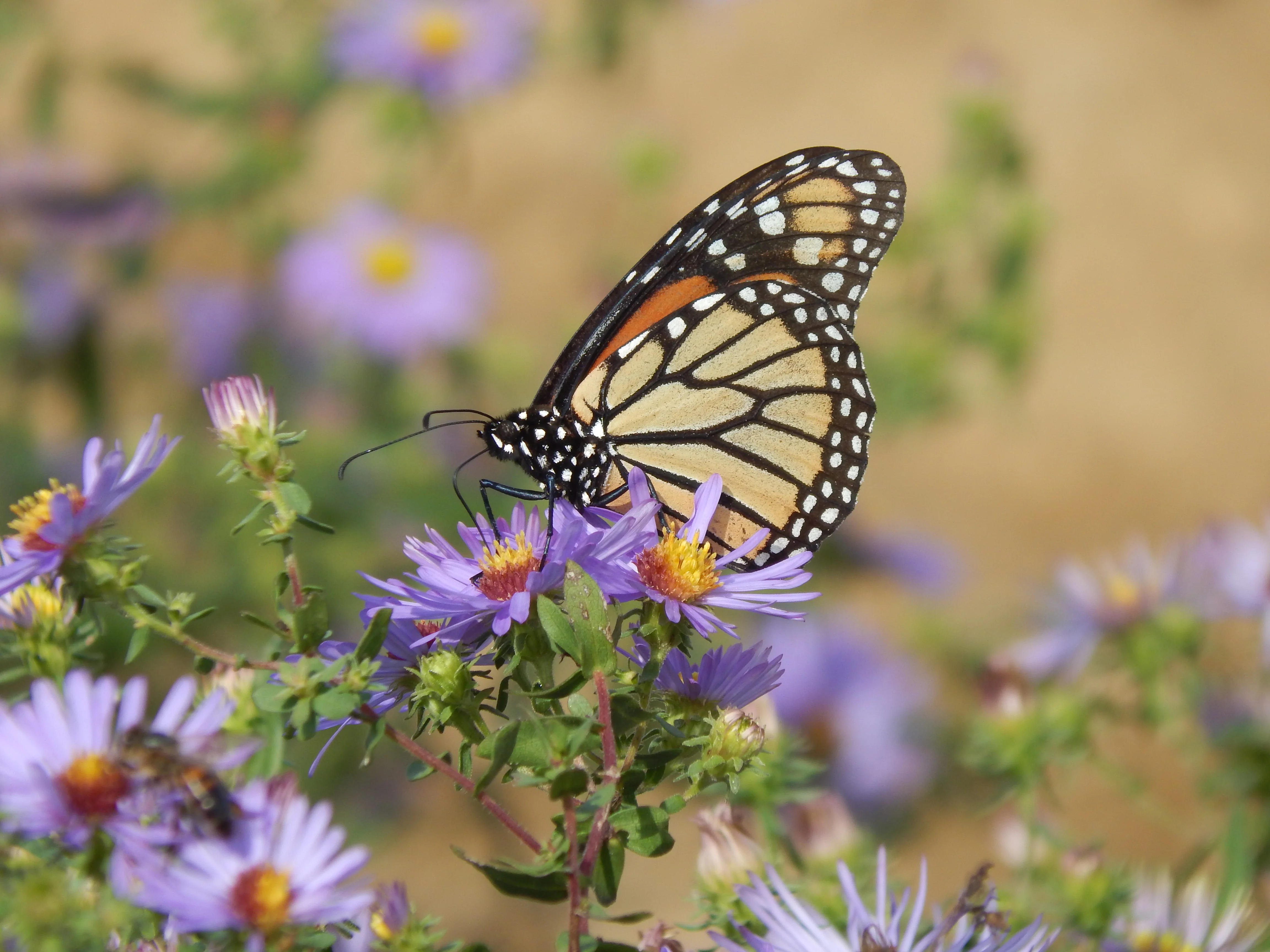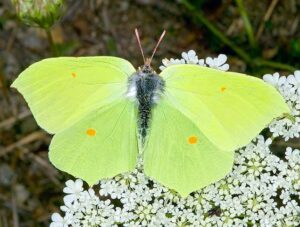Size and Family
- Family: Nymphalids
- Size: Large
- Wing Span Range (male to female): 95-100mm
Conservation Status
- Butterfly Conservation priority: Low
- European status: Not assessed
Caterpillar Foodplants
Caterpillars feed on various Milkweeds (Asclepias species), a plant which is not native to the British Isles, and this explains why the butterfly has not been recorded to have bred here.
The Monarch is the largest butterfly seen in the British Isles and is also one of our rarest migrants. Known for its ability to travel large distances, the migrations in North America are one of the greatest natural phenomena in the world – where the adult butterflies can migrate from as far north as Canada to the overwintering grounds in Mexico, the west coast of California and Florida.
Millions of the butterflies make a 2,000-mile (3,220km) journey each year from Canada to pass the winter in central Mexico’s warmer weather. But climate change, pesticides and the incursion of illegal loggers have seen the forests dwindle and with them, the number of monarchs.
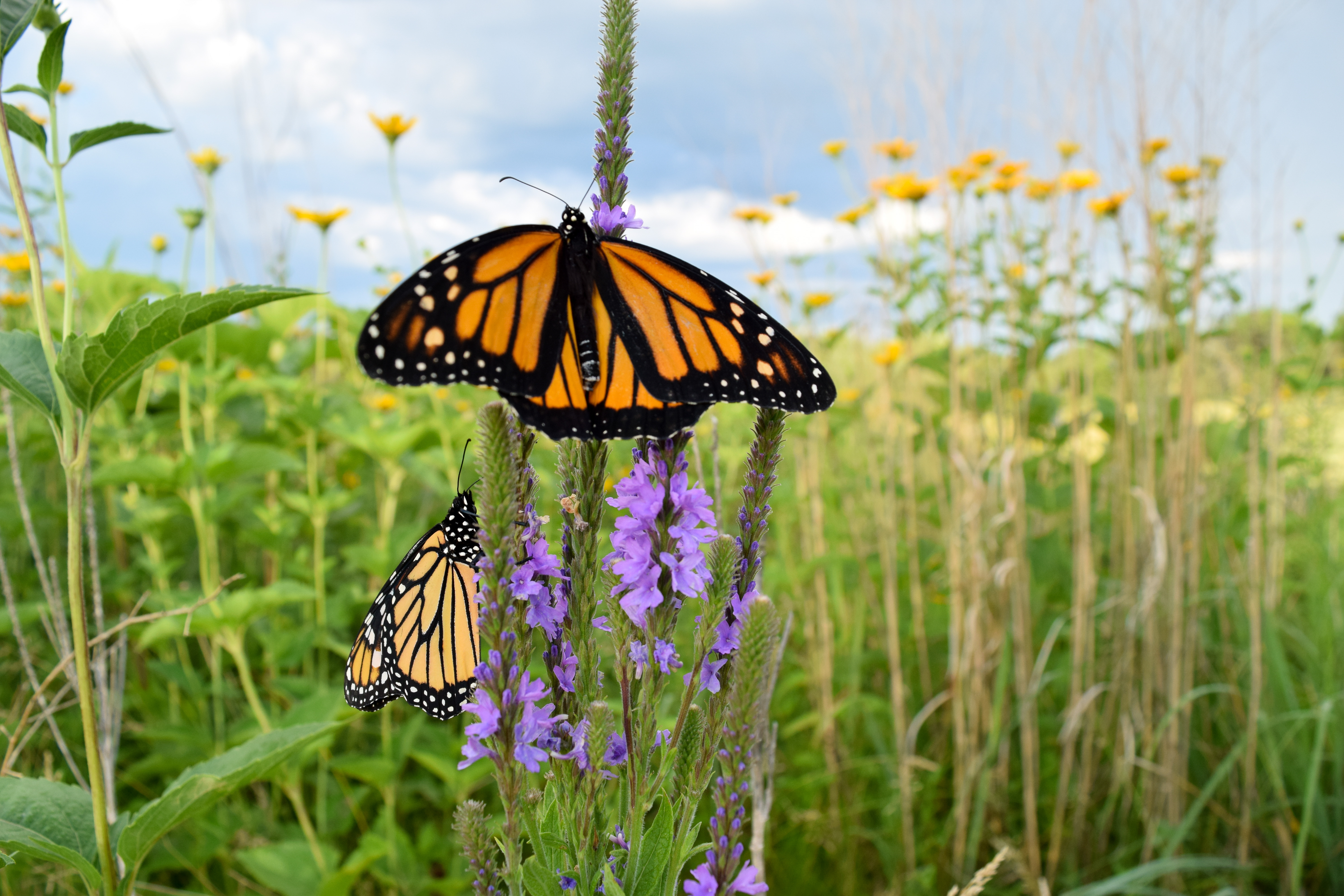
Monarch Butterfly: Habitat, Life Cycle, and Diet Facts
Habitat
Monarch butterflies (Danaus plexippus) are found across North America, from southern Canada to northern South America. They are particularly known for their incredible migratory patterns. Monarchs are divided into two main populations:
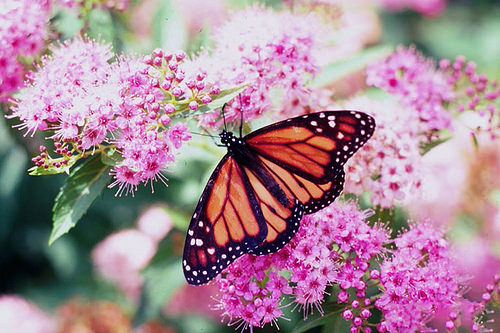
A rare migrant to the UK but in North America, the butterfly can be found almost anywhere that their foodplant grows, including farmland, gardens and even roadsides. The Monarch overwinters in sheltered forests made up of Eucalyptus trees, Monterey pines and Monterey cypresses.
- Eastern Population: Migrates from the northeastern United States and southeastern Canada to the mountain forests in central Mexico for the winter.
- Western Population: Migrates to coastal areas of central and southern California.
Monarchs require specific habitats for different stages of their life cycle:
- Breeding Grounds: Monarchs lay their eggs on milkweed plants, which are essential for the larvae (caterpillars) to develop.
- Nectar Sources: Adult monarchs feed on nectar from a variety of flowering plants. These nectar sources are crucial during migration to build up fat reserves.
- Overwintering Sites: In Mexico, monarchs overwinter in mountain forests, while in California, they use coastal groves[1][2][4].
Life Cycle
Monarch butterflies undergo complete metamorphosis, which includes four distinct stages: egg, larva (caterpillar), pupa (chrysalis), and adult.Like all Lepidoptera, monarchs undergo complete metamorphosis; their life cycle has four phases: egg, larva, pupa, and adult. Monarchs transition from eggs to adults during warm summer temperatures in as little as 25 days, extending to as many as seven weeks during cool spring conditions. During their development, both larvae and their milkweed hosts are vulnerable to weather extremes, predators, parasites, and diseases; commonly fewer than 10% of monarch eggs and caterpillars survive.
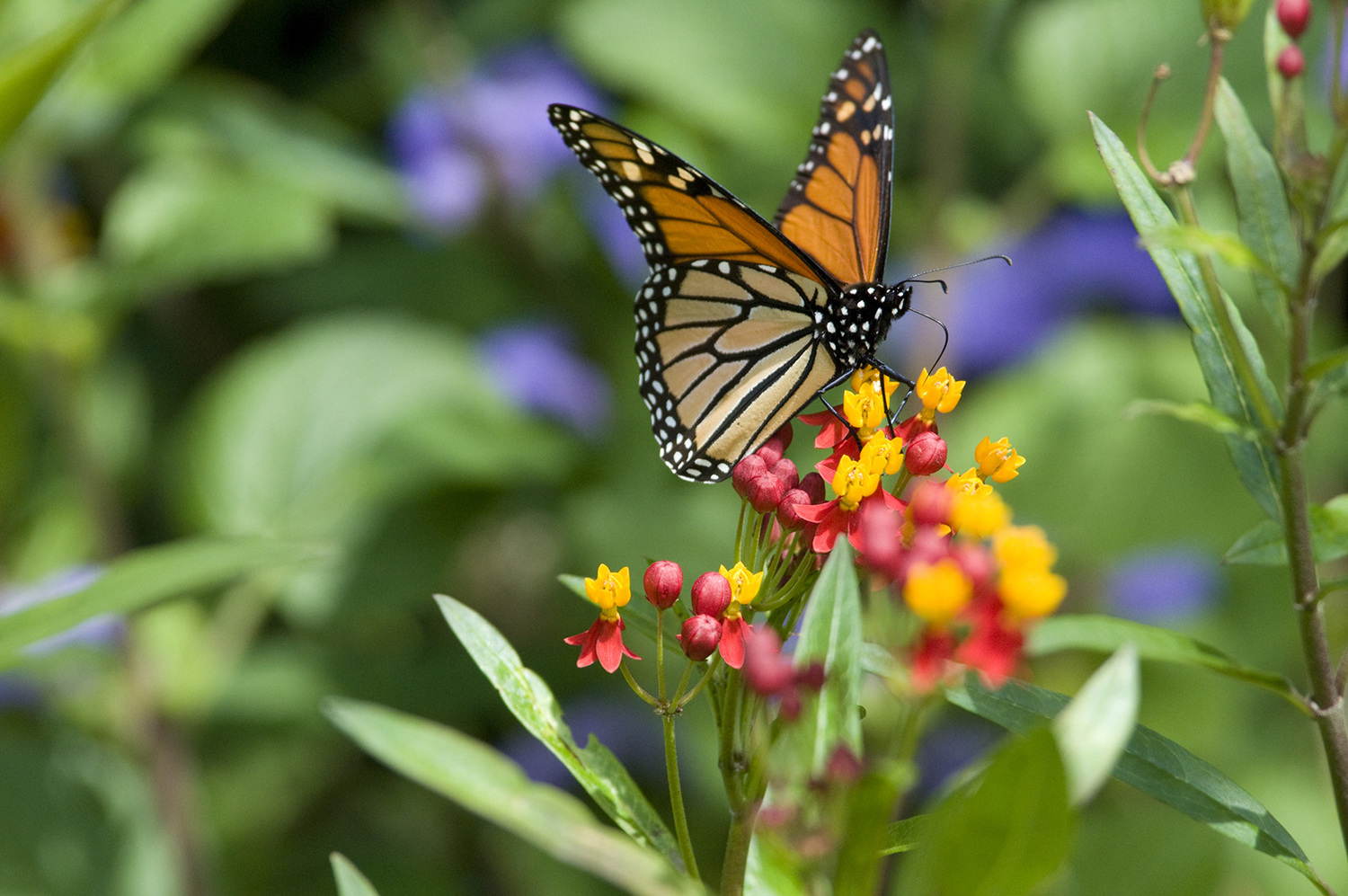
The female monarch butterfly lays each of her eggs individually on the leaf of a milkweed plant, attaching it with a bit of glue she secretes. A female usually lays between 300 and 500 eggs over a two- to five-week period.
After a few days, the eggs hatch into larvae, otherwise known as caterpillars in the moth and butterfly world. The caterpillars’ main job is to grow, so they spend most of their time eating. They only eat milkweed, which is why the female laid her eggs on milkweed leaves in the first place.
The caterpillars eat their fill for about two weeks, and then they spin protective cases around themselves to enter the pupa stage, which is also called “chrysalis.” About a week or two later, they finish their metamorphosis and emerge as fully formed, black-and-orange, adult monarch butterflies.
Monarch butterflies do different things depending on when they complete their metamorphosis. If they emerge in the spring or early summer, they’ll start reproducing within days. But if they’re born in the later summer or fall, they know winter is coming—time to head south for warmer weather.
- Egg: Female monarchs lay eggs exclusively on milkweed plants. The eggs hatch in about 3-5 days.
- Larva (Caterpillar): The caterpillar stage lasts about two weeks, during which the larvae feed on milkweed leaves and go through five instars (molts).
- Pupa (Chrysalis): After the larval stage, the caterpillar forms a chrysalis. This stage lasts approximately 8-15 days, during which the transformation into an adult butterfly occurs.
- Adult: Adult monarchs emerge from the chrysalis and spend several hours drying their wings before they can fly. Summer generations live for 2-5 weeks, while the final generation of the year, which migrates, can live up to nine months[3][4][6].
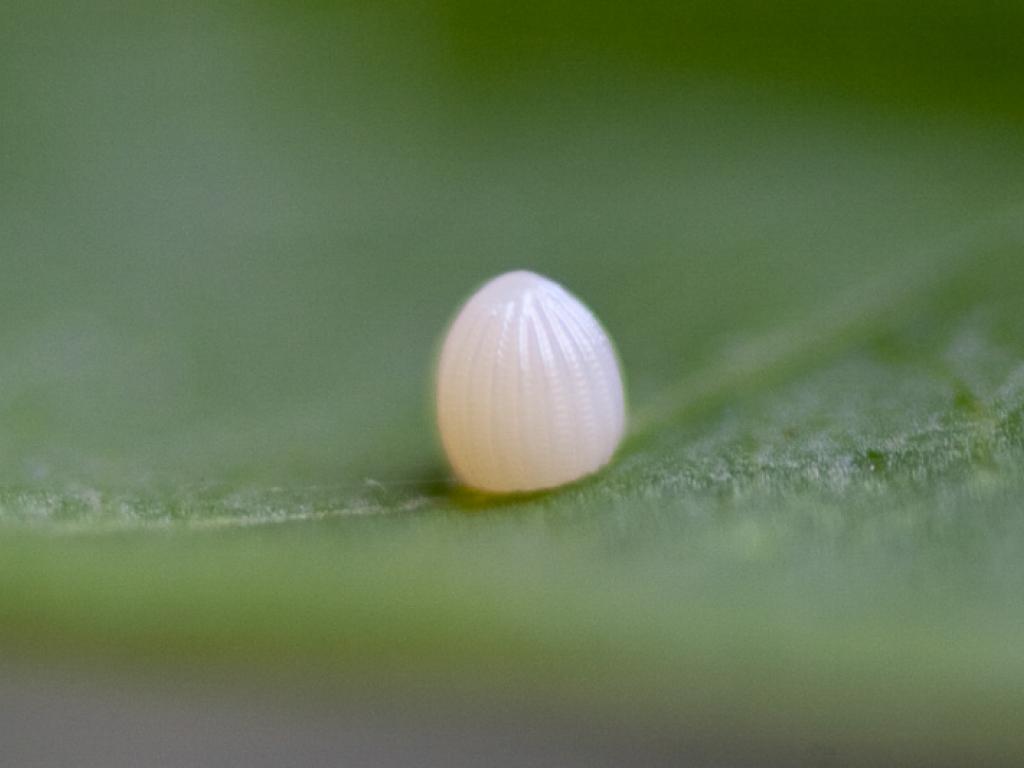
The larva (caterpillar) has five stages (instars), molting at the end of each instar. Instars last about 3 to 5 days, depending on factors such as temperature and food availability.
The first-instar caterpillar that emerges from the egg is pale green or grayish-white, shiny, and almost translucent, with a large, black head. It lacks banding coloration or tentacles. The larvae or caterpillar eats its egg case and begins to feed on milkweed with a circular motion, often leaving a characteristic, arc-shaped hole in the leaf. Older first-instar larvae have dark stripes on a greenish background and develop small bumps that later become front tentacles. The first instar is usually between 2 and 6 mm (0.079 and 0.236 in) long.
The second-instar larva develops a characteristic pattern of white, yellow, and black transverse bands. The larva has a yellow triangle on the head and two sets of yellow bands around this central triangle. It is no longer translucent, and is covered in short setae. Pairs of black tentacles begin to grow, a larger pair on the thorax and a smaller pair on the abdomen. The second instar is usually between 6 mm (0.24 in) and 1 cm (0.39 in) long.
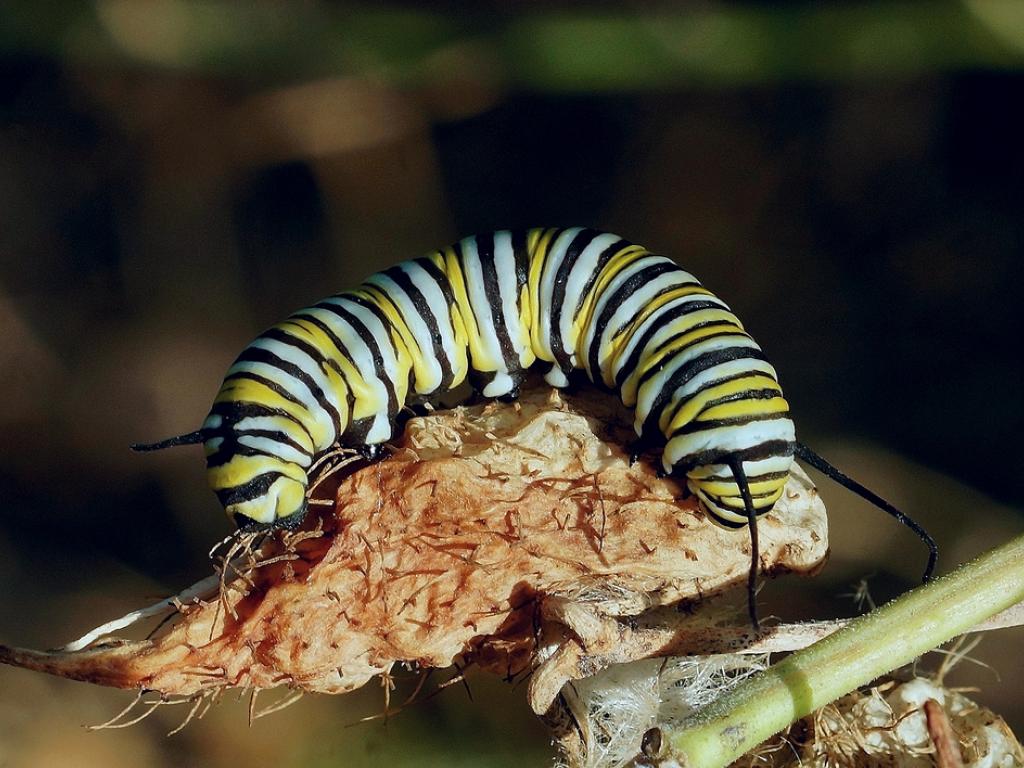
The larva (caterpillar) has five stages (instars), molting at the end of each instar. Instars last about 3 to 5 days, depending on factors such as temperature and food availability.
The first-instar caterpillar that emerges from the egg is pale green or grayish-white, shiny, and almost translucent, with a large, black head. It lacks banding coloration or tentacles. The larvae or caterpillar eats its egg case and begins to feed on milkweed with a circular motion, often leaving a characteristic, arc-shaped hole in the leaf. Older first-instar larvae have dark stripes on a greenish background and develop small bumps that later become front tentacles. The first instar is usually between 2 and 6 mm (0.079 and 0.236 in) long.
The second-instar larva develops a characteristic pattern of white, yellow, and black transverse bands. The larva has a yellow triangle on the head and two sets of yellow bands around this central triangle. It is no longer translucent, and is covered in short setae. Pairs of black tentacles begin to grow, a larger pair on the thorax and a smaller pair on the abdomen. The second instar is usually between 6 mm (0.24 in) and 1 cm (0.39 in) long.
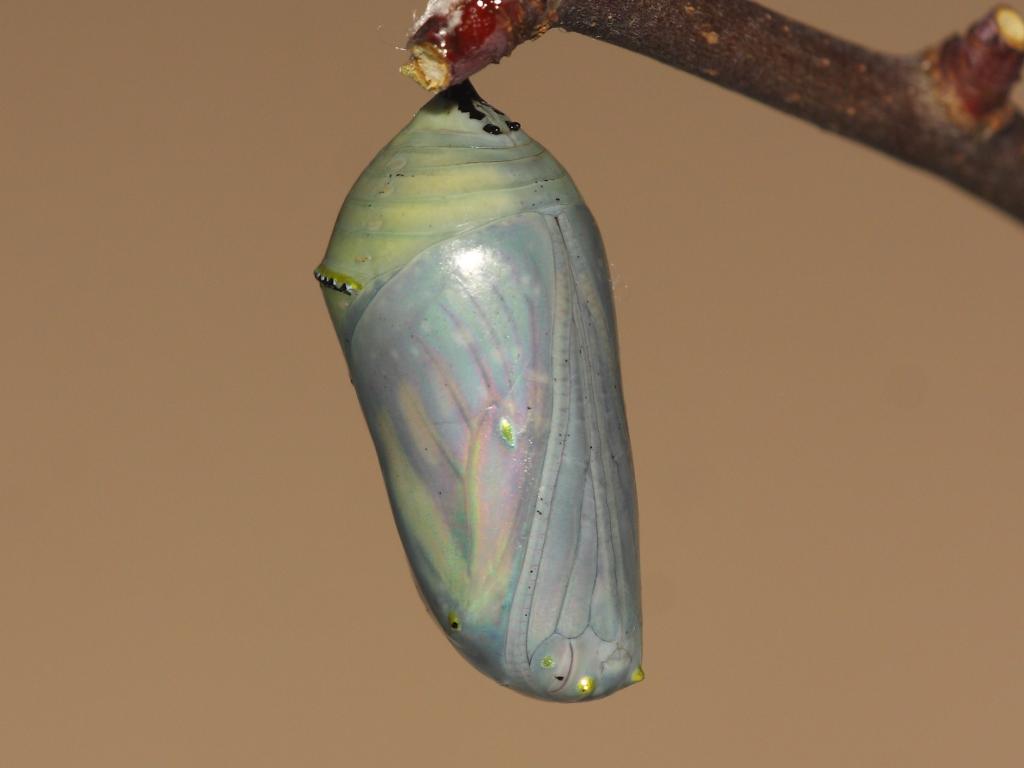
To prepare for the pupal or chrysalis stage, the caterpillar chooses a safe place for pupation, where it spins a silk pad on a downward-facing horizontal surface. At this point, it turns around and securely latches on with its last pair of hind legs and hangs upside down, in the form of the letter J. After “J-hanging” for about 12–16 hours, it soon straightens out its body and goes into peristalsis some seconds before its skin splits behind its head. It then sheds its skin over a period of a few minutes, revealing a green chrysalis . At first, the chrysalis is long, soft, and somewhat amorphous, but over a few hours, it compacts into its distinct shape – an opaque, pale-green chrysalis with small golden dots near the bottom, and a gold-and-black rim around the dorsal side near the top. At first, its exoskeleton is soft and fragile, but it hardens and becomes more durable within about a day. At this point, it is about 2.5 cm (0.98 in) long and 10–12 mm (0.39–0.47 in) wide, weighing about 1.2 g (0.042 oz). At normal summer temperatures, it matures in 8–15 days (usually 11–12 days). During this pupal stage, the adult butterfly forms inside. A day or so before emerging, the exoskeleton first becomes translucent and the chrysalis more bluish. Finally, within 12 hours or so, it becomes transparent, revealing the black and orange colors of the butterfly inside before it ecloses (emerges).
Diet
Monarch butterflies have different diets at different stages of their life cycle:
- Larvae (Caterpillars): Feed exclusively on milkweed plants. Milkweed contains toxic compounds called cardiac glycosides, which the caterpillars store in their bodies, making them unpalatable to predators.
- Adults: Feed on nectar from a variety of flowering plants. They require nectar to sustain their energy needs, especially during migration. Common nectar sources include milkweed flowers and other blooming native plants[1][4][5].
Conservation Status and Threats
Monarch butterflies are currently listed as endangered due to several threats:
- Habitat Loss: Urban development and agricultural expansion have reduced the availability of milkweed and nectar sources.
- Climate Change: Alters weather patterns, affecting both breeding and overwintering habitats.
- Pesticides and Herbicides: Reduce the availability of milkweed and other plants essential for monarchs[2].
Efforts to conserve monarch butterflies include planting milkweed and nectar plants, protecting overwintering sites, and reducing pesticide use[2][5].
Monarch butterflies are a remarkable species with a fascinating life cycle and critical ecological roles. Conservation efforts are essential to ensure their survival and the continuation of their incredible migratory journeys.

